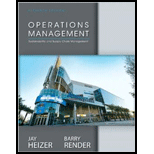
Strategy at Regal Marine ☆
Video Case
Regal Marine, one of the U.S.’s 10 largest power-boat manufacturers, achieves its mission—providing luxury performance boats to customers worldwide—using the strategy of differentiation. It differentiates its products through constant innovation, unique features, and high quality. Increasing sales at the Orlando, Florida, family-owned firm suggest that the strategy is working.
As a quality boat manufacturer, Regal Marine starts with continuous innovation, as reflected in computer-aided design (CAD), high-quality molds, and close tolerances that are controlled through both defect charts and rigorous visual inspection. In-house quality is not enough, however. Because a product is only as good as the parts put into it, Regal has established close ties with a large number of its suppliers to ensure both flexibility and perfect parts. With the help of these suppliers, Regal can profitably produce a product line of 22 boats, ranging from the $14,000 19-foot boat to the $500,000 44-foot Commodore yacht.
“We build boats,” says VP Tim Kuck, “but we’re really in the ‘fun’ business. Our competition includes not only 300 other boat, canoe, and yacht manufacturers in our $17 billion industry, but home theaters, the Internet, and all kinds of alternative family entertainments.” Fortunately Regal has been paying down debt and increasing market share.
Regal has also joined with scores of other independent boat makers in the American Boat Builders Association. Through economies of scale in procurement, Regal is able to navigate against billion-dollar competitor Brunswick (makers of the Sea Ray and Bayliner brands). The Global Company Profile featuring Regal Marine (which opens Chapter 5) provides further background on Regal and its strategy.
Discussion Questions*
* You may wish to view the video that accompanies the case before addressing these questions.
1. State Regal Marine's mission in your own words.
Want to see the full answer?
Check out a sample textbook solution
Chapter 2 Solutions
Operations Management
- 1. Define risk management and explain its importance in a small business. 2. Describe three types of risks commonly faced by entrepreneurs. 3. Explain the purpose of a risk register. 4. List and briefly describe four risk response strategies. (5 marks) (6 marks) (4 marks) (8 marks) 5. Explain how social media can pose a risk to small businesses. (5 marks) 6. Identify and describe any four hazard-based risks. (8 marks) 7. Mention four early warning indicators that a business may be at risk. (4 marks)arrow_forwardState whether each of the following statements is TRUE or FALSE. 1. Risk management involves identifying, analysing, and mitigating risks. 2. Hazard risks include interest rate fluctuations. 3. Entrepreneurs should avoid all forms of risks. 4. SWOT analysis is a tool for risk identification. 5. Scenario building helps visualise risk responses. 6. Risk appetite defines how much risk an organisation is willing to accept. 7. Diversification is a risk reduction strategy. 8. A risk management framework must align with business goals. 9. Political risk is only relevant in unstable countries. 10. All risks can be eliminated through insurance.arrow_forward9. A hazard-based risk includes A. Political instability B. Ergonomic issues C. Market demand D. Taxation changesarrow_forward
- 8. Early warning indicators help businesses to A. Avoid legal actions B. Grow rapidly C. Detect potential risks D. Hire employees 9. A hazard-based risk includes A. Political instability B. Ergonomic issues C. Market demand D. Taxation changesarrow_forward10. Which risk category refers to taking advantage of a new opportunity despite potential challenges? A. Hazard B. Uncertainty C. Opportunity D. Strategicarrow_forward6. A business continuity plan is mainly used to_ A. Increase profits B. Handle daily tasks C. Prepare for disruptions D. Advertise services 7. What is the role of a risk owner? A. To finance the risk B. To monitor and manage a specific risk C. To create risks D. To avoid planning 8. Early warning indicators help businesses to_ A. Avoid legal actions B. Grow rapidly C. Detect potential risks D. Hire employees 9. A hazard-based risk includes_ A. Political instability B. Ergonomic issues C. Market demand D. Taxation changesarrow_forward
 Management, Loose-Leaf VersionManagementISBN:9781305969308Author:Richard L. DaftPublisher:South-Western College Pub
Management, Loose-Leaf VersionManagementISBN:9781305969308Author:Richard L. DaftPublisher:South-Western College Pub Foundations of Business (MindTap Course List)MarketingISBN:9781337386920Author:William M. Pride, Robert J. Hughes, Jack R. KapoorPublisher:Cengage Learning
Foundations of Business (MindTap Course List)MarketingISBN:9781337386920Author:William M. Pride, Robert J. Hughes, Jack R. KapoorPublisher:Cengage Learning Foundations of Business - Standalone book (MindTa...MarketingISBN:9781285193946Author:William M. Pride, Robert J. Hughes, Jack R. KapoorPublisher:Cengage LearningMarketingMarketingISBN:9780357033791Author:Pride, William MPublisher:South Western Educational Publishing
Foundations of Business - Standalone book (MindTa...MarketingISBN:9781285193946Author:William M. Pride, Robert J. Hughes, Jack R. KapoorPublisher:Cengage LearningMarketingMarketingISBN:9780357033791Author:Pride, William MPublisher:South Western Educational Publishing





